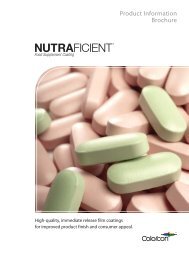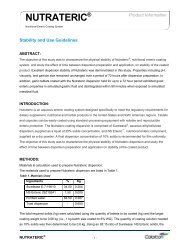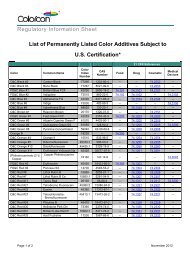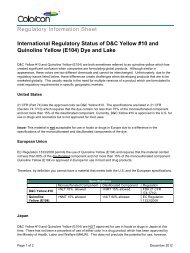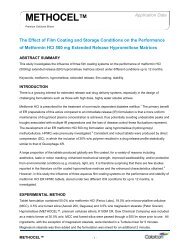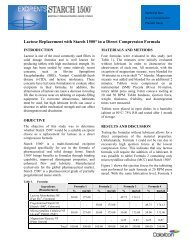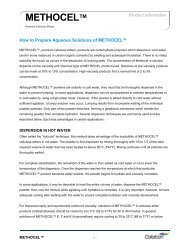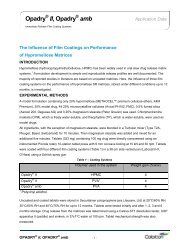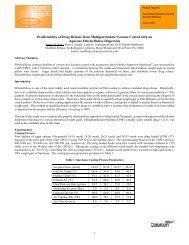Applications of Complementary Polymers in HPMC ... - Colorcon
Applications of Complementary Polymers in HPMC ... - Colorcon
Applications of Complementary Polymers in HPMC ... - Colorcon
Create successful ePaper yourself
Turn your PDF publications into a flip-book with our unique Google optimized e-Paper software.
simulated <strong>in</strong>test<strong>in</strong>al fluid as it is expected to<br />
behave like a soluble filler and result <strong>in</strong> a<br />
faster drug release rate. It has been proposed<br />
that the retardation <strong>of</strong> drug release is<br />
attributable to the synergistic <strong>in</strong>teraction<br />
between PVAP and <strong>HPMC</strong>, result<strong>in</strong>g <strong>in</strong> the<br />
formation <strong>of</strong> a stronger gel layer and<br />
consequent slower diffusion and erosion rates.<br />
Sodium alg<strong>in</strong>ate has also been used<br />
with<strong>in</strong> <strong>HPMC</strong> matrices to obta<strong>in</strong> a pH<strong>in</strong>dependent<br />
release pr<strong>of</strong>ile for basic drugs. 33,34<br />
It has been reported that at low pH (<strong>in</strong> gastric<br />
environment), sodium alg<strong>in</strong>ate precipitates <strong>in</strong><br />
the hydrated gel layer as alg<strong>in</strong>ic acid. This<br />
alg<strong>in</strong>ic acid then provides a firm structure to<br />
the gel and retards rate <strong>of</strong> erosion. Solubility<br />
<strong>of</strong> basic drugs at this pH is high, hence<br />
diffusion through the matrix gel layer<br />
predom<strong>in</strong>ates as a mechanism <strong>of</strong> drug release.<br />
At higher pH values, the alg<strong>in</strong>ate rema<strong>in</strong>s as<br />
the soluble salt, thus provid<strong>in</strong>g less resistance<br />
to erosion. Erosion <strong>of</strong> the matrix facilitates<br />
release <strong>of</strong> the drug substance at these pH<br />
values, where drug solubility is reduced due to<br />
higher environmental pH. The balance <strong>of</strong><br />
erosive and diffusive mechanisms at the pH<br />
extremes may expla<strong>in</strong> the pH-<strong>in</strong>dependent<br />
drug release. This balance is required to be<br />
optimized for each new drug candidate to be<br />
<strong>in</strong>corporated, pr<strong>in</strong>cipally ensur<strong>in</strong>g an adequate<br />
erosion rate at higher pH values compensate<br />
for the fall-<strong>of</strong>f <strong>in</strong> driv<strong>in</strong>g force for<br />
diffusion/dissolution-mediated release as drug<br />
solubility decreases. There are commercially<br />
available ER matrices us<strong>in</strong>g the comb<strong>in</strong>ation<br />
<strong>of</strong> <strong>HPMC</strong> and sodium alg<strong>in</strong>ate. 35<br />
Sodium carboxymethylcellulose (Na<br />
CMC) has been reported to have synergistic<br />
hydrogen-bond<strong>in</strong>g <strong>in</strong>teractions with <strong>HPMC</strong>. 36-<br />
38<br />
Baveja et al reported comb<strong>in</strong><strong>in</strong>g <strong>HPMC</strong> with<br />
Na CMC may result <strong>in</strong>to zero-order release<br />
pr<strong>of</strong>iles for the drugs propranolol<br />
hydrochloride, metoprolol tartrate, oxprenolol<br />
hydrochloride, and alprenolol hydrochloride. 39<br />
The authors postulated that the polymers<br />
showed a synergistic <strong>in</strong>crease <strong>in</strong> viscosity,<br />
which allowed erosion to occur at a rate<br />
equat<strong>in</strong>g to the movement <strong>of</strong> the front between<br />
the glassy and the rubbery polymer. However,<br />
it was later confirmed that enhancement <strong>in</strong><br />
viscosity was not solely responsible for<br />
modulat<strong>in</strong>g the drug release pr<strong>of</strong>ile, but that<br />
the complex formation between the anionic<br />
polymer and cationic drug also played an<br />
important role. 40 Freely soluble cationic drugs<br />
have been reported to be released slower from<br />
comb<strong>in</strong>ations <strong>of</strong> <strong>HPMC</strong> and Na CMC<br />
matrices than when formulated with <strong>HPMC</strong><br />
alone, an effect attributed to drug/polymer<br />
<strong>in</strong>teraction. However, for less-soluble drugs,<br />
which are released pr<strong>in</strong>cipally by erosion, this<br />
effect has been reported to be reversed. There<br />
are commercially available ER matrices us<strong>in</strong>g<br />
comb<strong>in</strong>ations <strong>of</strong> <strong>HPMC</strong> and Na CMC. 41<br />
Comb<strong>in</strong>ation <strong>of</strong> <strong>HPMC</strong> with xanthan<br />
gum has been reported to result <strong>in</strong> greater<br />
retardation <strong>in</strong> drug release pr<strong>of</strong>ile compared to<br />
s<strong>in</strong>gle polymer systems. 12,42 Rapid hydration <strong>of</strong><br />
xanthan gum comb<strong>in</strong>ed with firm gel strength<br />
<strong>of</strong> <strong>HPMC</strong> have been attributed to slower drug<br />
release <strong>of</strong> high-solubility APIs. In this system,<br />
the <strong>in</strong>itial burst release, which is typical <strong>of</strong><br />
highly soluble drugs, was controlled by rapid<br />
hydration <strong>of</strong> xanthan gum, whereas<br />
subsequent drug release and matrix <strong>in</strong>tegrity<br />
were ma<strong>in</strong>ta<strong>in</strong>ed by the firm gel <strong>of</strong> <strong>HPMC</strong>. 12<br />
The rapid gel formation property <strong>of</strong> xanthan<br />
gum has also been exploited <strong>in</strong> gas-generat<strong>in</strong>g<br />
gastro-retentive matrices <strong>of</strong> cipr<strong>of</strong>loxac<strong>in</strong><br />
T A B L E 1<br />
FDA Registered Oral ER Formulations Conta<strong>in</strong><strong>in</strong>g Commonly Used Hydrophilic or Water-Insoluble<br />
<strong>Polymers</strong> #<br />
formulated with <strong>HPMC</strong>. 43<br />
Comb<strong>in</strong>ation <strong>of</strong> <strong>HPMC</strong> with carbomers<br />
has been studied for achiev<strong>in</strong>g ER<br />
characteristics for various drugs. 44,45 The<br />
reported advantages with the use <strong>of</strong> this blend<br />
composition were the use <strong>of</strong> low levels <strong>of</strong> the<br />
total polymer <strong>in</strong> the matrix, flexibility <strong>in</strong> drug<br />
release modulation, and ability to extend the<br />
release <strong>of</strong> some cationic drugs.<br />
Recently, the work <strong>of</strong> our research group<br />
has shown that comb<strong>in</strong><strong>in</strong>g <strong>HPMC</strong> with<br />
carbomer and polyv<strong>in</strong>yl acetate phthalate<br />
(PVAP) <strong>in</strong> a matrix system resulted <strong>in</strong> slower<br />
drug release as compared to matrices<br />
compris<strong>in</strong>g s<strong>in</strong>gle or b<strong>in</strong>ary polymer<br />
systems. 46 This has been related to a<br />
synergistic <strong>in</strong>crease <strong>in</strong> the viscosity, and<br />
therefore gel strength, <strong>of</strong> the matrix, possibly<br />
due to stronger hydrogen bond<strong>in</strong>g between -<br />
OH groups <strong>of</strong> <strong>HPMC</strong> and the carboxylic<br />
groups <strong>of</strong> the carbomer or PVAP. This stronger<br />
hydrogen-bond<strong>in</strong>g between the polymers<br />
resulted <strong>in</strong> a more rigid structure through<br />
which drug diffusion can occur. The <strong>in</strong>fluence<br />
<strong>of</strong> comb<strong>in</strong>ation <strong>of</strong> carbomer, PVAP, and<br />
<strong>HPMC</strong> blend <strong>in</strong> a matrix formulation <strong>of</strong> a<br />
Drug Delivery Technology July/August 2009 Vol 9 No 7<br />
25



